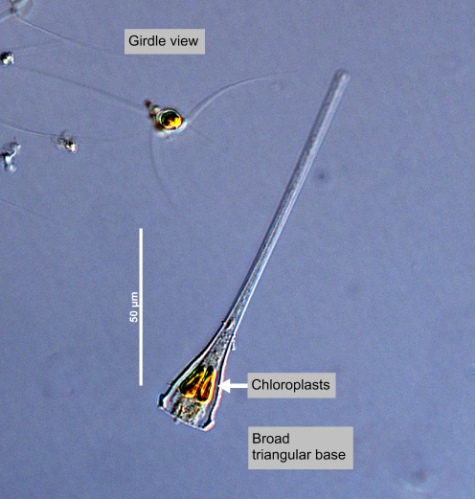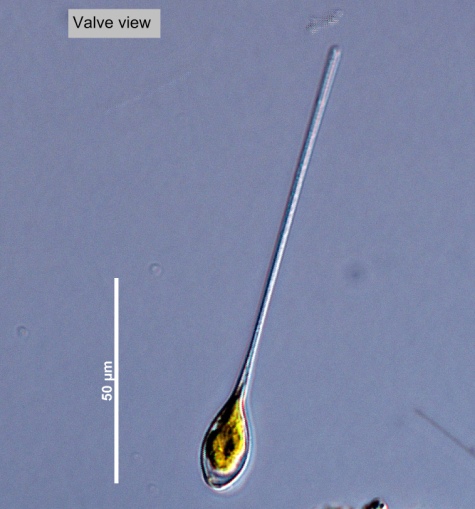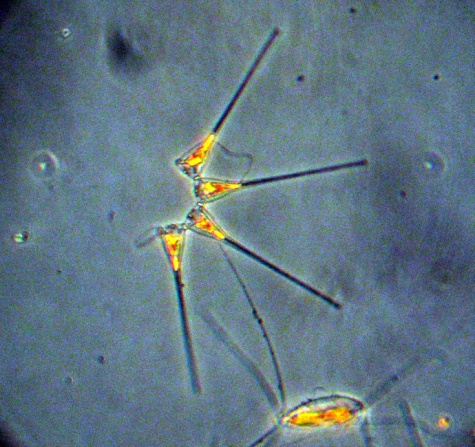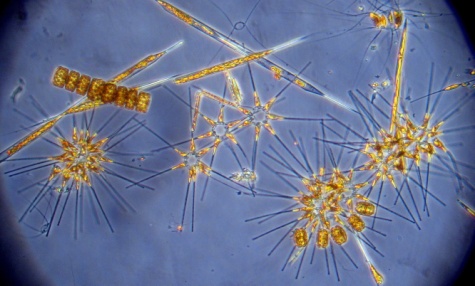




|
Synonym(s)
Homotypic
Expressing the same fundamental type or structure; may or may not be symmetrical (e.g., the two valves of a diatom, where they are the same shape and appearance, but one is bigger than the other). In naming species, a homotypic synonym is one that comes into being when a taxon gets a new name (without being added to an already existing taxon).
(homotypic, CloseBasionym
The original name for an organism. In botany, the original published nomenclature from which a new binomial nomenclature is derived for a particular group of organisms (Tindall 1999).
basionym)Asterionella japonica Cleve 1882 Close
Heterotypic
A difference in type. In naming species, a heterotypic synonym is one that comes into being when a taxon becomes part of a different taxon. Compare to homotypic.
(heterotypic)(Guiry and Guiry 2012)
Classification
(Guiry and Guiry 2012)
Lifestyle
Description
Girdle
In diatoms, the portion of the cell wall between the two valves of a cell; made up of intercalary bands (bands closest to the valves) and connecting bands (bands in the middle of the girdle). In dinoflagellates, the equivalent of a cingulum or transverse furrow (Horner 2002).
girdle view, cells have a narrow and elongated neck with a broad triangular base (Cupp 1943). The end of the neck is not lobed. Adjacent cells are attached by the valve face of the base; therefore cells are usually seen in girdle view (Kraberg et al. 2010). In valve view, the base is lobed. One or two plate-like chloroplasts are located in the base (Cupp 1943). Cells are yellow-brown in colour (Guiry 2012).SEM
(scanning electron microscope) A microscope which applies "a focused beam of high-energy electrons to generate a variety of signals at the surface of solid specimens" (NSF 2011).
SEM: "Slit fields or CloseApical
(axis, spine) The region of the apex or point. Refers to the most anterior point or region of the cell (HPP 2003).
apical pores at both ends of valve. A single CloseLabiate process
In diatoms, a simple slit in the valve wall with two internal lips, one on each side of the slit. They can be useful in identification because they are positioned differently in different species (Horner 2002).
labiate process present at the narrow end of the valve" (Horner 2002). Transapical CloseStriae
(referring to pores in diatoms) In diatoms, a striation or row of pores on the valve face. "In centric diatoms, striae may be radial, running from the centre of the valve to the margin ... In pennate diatoms, striae may be parallel to the median line of the valve or raphe" (Horner 2002).
striae are very delicate (Cupp 1943).Measurements
Length of base: 10 - 25 μm
Width of base Close
Transapical axis
In diatoms, the longitudinal axis of the valve.
(transapical axis): 7 - 18 μmHeight of base Close
Pervalvar axis
The axis through the centre point of the two valves of a frustule. This axis is perpendicular to the valve face.
(pervalvar axis): 5 - 15 μmTransapical striae: 28 - 34 in 10 μm
(Cupp 1943, Kraberg et al. 2010)
Similar species
Harmful effects
Habitat
Benthic
The ecological zone at the bottom of a body of water.
benthic (Brown and McLachlan 1990). Sometimes regarded as an CloseEstuarine
Of or relating to estuaries.
estuarine species (Jouenne et al. 2007).Distribution
Upwelling
A wind-driven mechanism of mixing the water column. Cold, dense, nutrient-rich, and often oxygen-poor water from depths rises to replace the warmer nutrient-poor surface water. This input of nutrients can have a significantly increase primary productivity in a region (Dugdale 1985).
upwellings and CloseStratification
The development of distinct non-mixing layers in the water column resulting from a steep gradient in density, which is caused by differences in temperature and/or salinity.
stratifications in Northwest Spain (Z&uactue;ñiga et al. 2011). Blooms in spring in the Bay of Bengal, India (Mishra et al. 2006). More abundant in the winter around Southern Brazil due to frequent southerly winds (Rörig and Garcia 2003, cited in Odebrecht et al. 2010).Growth conditions
Environmental Ranges
Temperature range (°C): 2.147 - 29.386
Nitrate (μmol L-1): 0.056 - 20.029
Salinity (PSU): 30.638 - 37.775
Oxygen (mL L-1): 4.515 - 7.716
Phosphate (μmol L-1): 0.061 - 1.656
Close
Silicic acid
A general term to describe chemical compounds containing silicon, oxygen and hydrogen with a general formula of [SiOx(OH)4-2x]n. Diatoms polymerize silicic acid into biogenic silica to form their frustules (Azam and Chisholm 1976).
Silicate (μmol L-1): 0.733 - 35.557(OBIS, cited in EOL)
Bloom characteristics
References
Brown, A. C. and McLachlan, A. 1990. Ecology of sandy shores. Elsevier, Amsterdam. 328.
Cupp, E. E. 1943. Marine Plankton Diatoms of the West Coast of North America. University of California Press. Berkeley, California. 238.
Encyclopedia of Life (EOL). 2012. Asterionellopsis glacialis. http://eol.org/pages/912258/overview. Accessed 21 Jan 2012.
Guiry, M. D. 2012. Asterionellopsis glacialis (Castracane) Round, 1990. http://www.marinespecies.org/aphia.php?p=taxdetails&id=149139. Accessed 21 Jan 2012.
Guiry, M. D. and Guiry, G. M. 2012. Asterionellopsis glacialis (Castracane) Round. http://www.algaebase.org/search/species/detail/?species_id=37056. Accessed 21 Jan 2012.
Hasle, G. R. and Syvertsen, E. E. 1997. Marine diatoms. In: Tomas, C.R. (ed.) Identifying Marine Phytoplankton. Academic Press, Inc., San Diego. 5-385.
Horner, R. A. 2002. A Taxonomic Guide To Some Common Phytoplankton. Biopress Limited, Dorset Press, Dorchester, UK. 200.
Jouenne, F., Lefebvre, S., Véron, B. and Lagadeuc, Y. Phytoplankton community structure and primary production in small intertidal estuarine-bay ecosystem (eastern English Channel, France). Marine Biology. 151: 805-825.
Kraberg, A., Baumann, M. and Durselen, C. D. 2010. Coastal Phytoplankton: Photo Guide for Northern European Seas. Verlag Dr. Friedrich Pfeil, Munchen, Germany. 204.
Mishra, S., Sahu, G., Mohanty, A. K., Singh, S. K. and Panigrahy, R. C. 2006. Impact of the diatom Asterionella glacialis (Castracane) bloom on the water quality and phytoplankton community structure in coastal waters of Gopalpur Sea, Bay of Bengal. Asian Journal of Water, Environment and Pollution. 3(2): 71-77.
Ocean Biogeographic Information System (OBIS). 2012. Asterionellopsis glacialis. http://www.iobis.org/mapper/?taxon_id=407088. Accessed 21 Jan 2012.
Odebrecht, C., Bergesch, M., Rörig, L. R. and Abreu, P. C. 2010. Phytoplankton interannual variability at Cassino Beach, Southern Brazil (1992-2007), with emphasis on the surf zone diatom Asterionellopsis glacialis. 33(2): 570-583.
Odebrecht, C., Segatto, A. Z. and Freitas, C. A. 1995. Surf-zone chlorophyll a variability at Cassino Beach, Southern Brazil. Estuarine Coastal and Shelf Science. 41: 81-90.
Pannard, A., Claquin, P., Klein, C., Le Roy, B. and Véron, B. 2008. Short-term variability of the phytoplankton community in coastal ecosystem in response to physical and chemical conditions' changes. Estuarine, Coastal and Shelf Science. 80(2): 212-224.
Rörig, L. R. and Garcia, V. M. T. 2003. Accumulations of the surf-zone diatom Asterionellopsis glacialis (Castracane) Round in Cassino Beach, Southern Brazil, and its relationship with environmental factors. Journal of Coastal Research. 19: 167-177.
Rousseau, V., Leynaert, A., Daoud, N. and Lancelot, C. Diatom succession, silicification and silicic acid availability in Belgian coastal waters (Southern North Sea). Marine Ecology Progress Series. 236: 61-73.
Zúñiga, D., Alonso-Pérez, F., Castro, C. G., Arbones, B. and Figueiras, F. G. 2011. Seasonal contribution of living phytoplankton carbon to vertical fluxes in a coastal upwelling system (Ría de Vigo, NW Spain). Continental Shelf Research. 31(5): 414-424.
